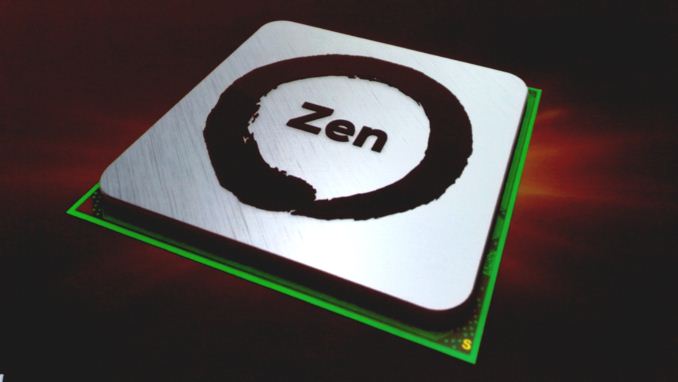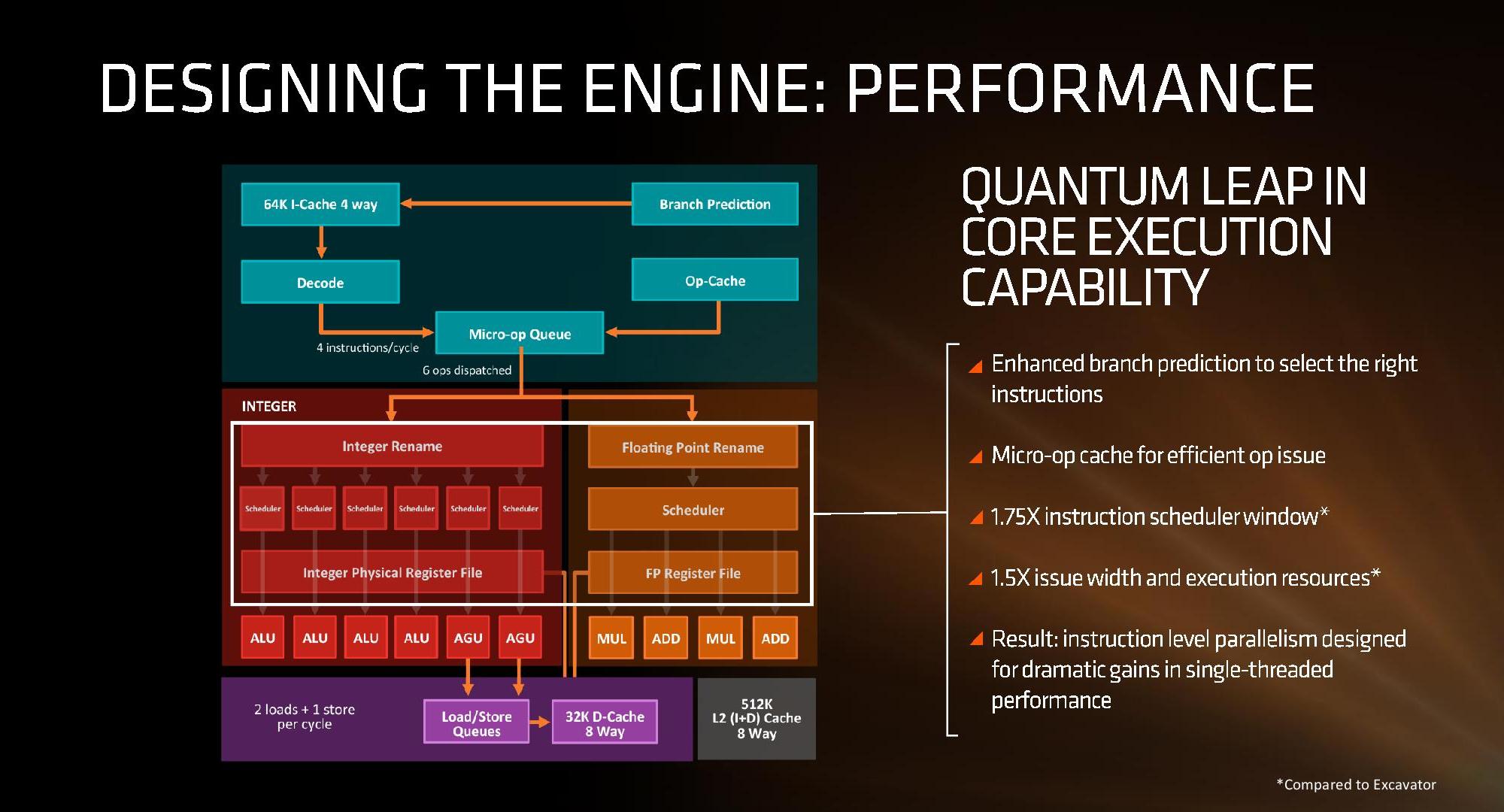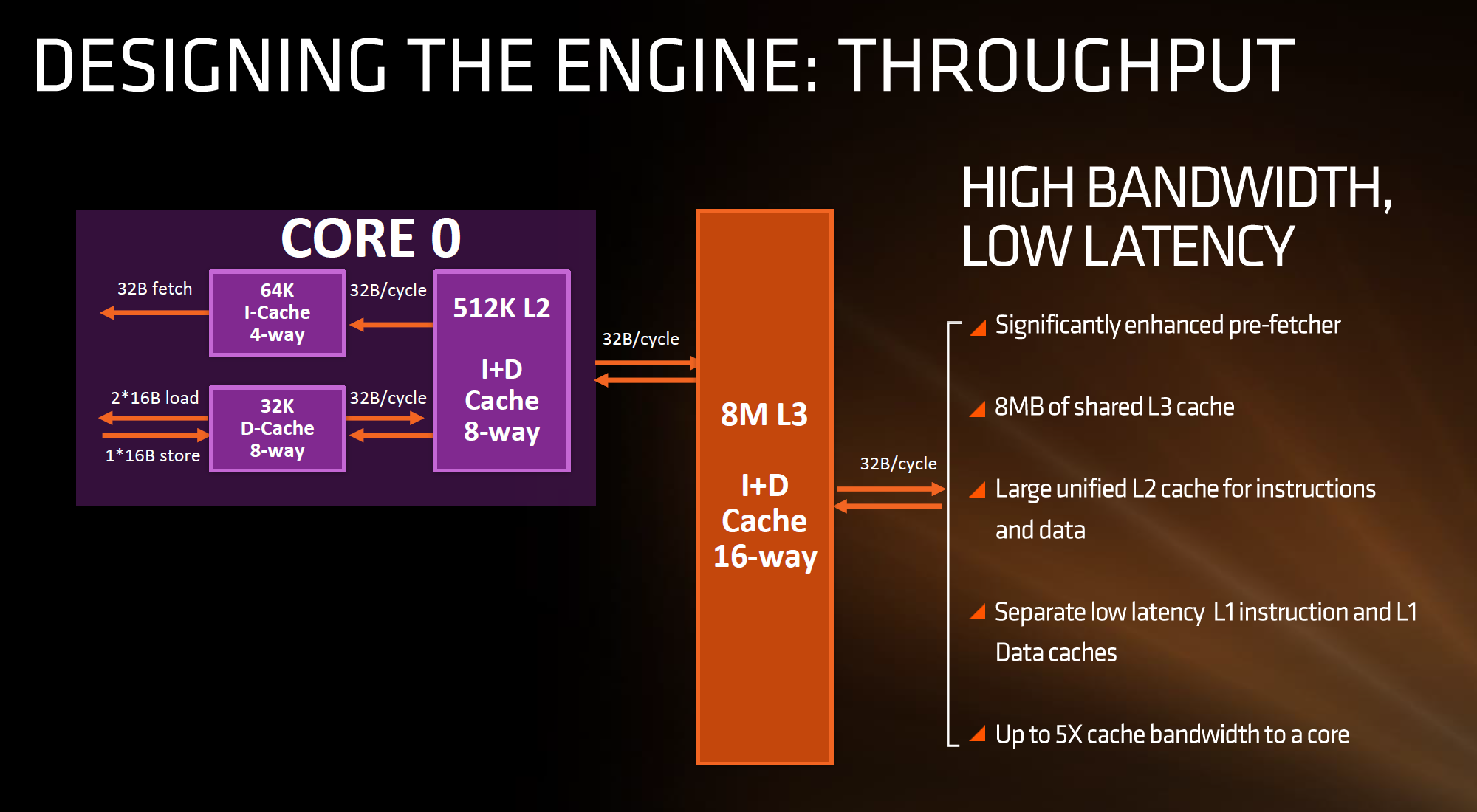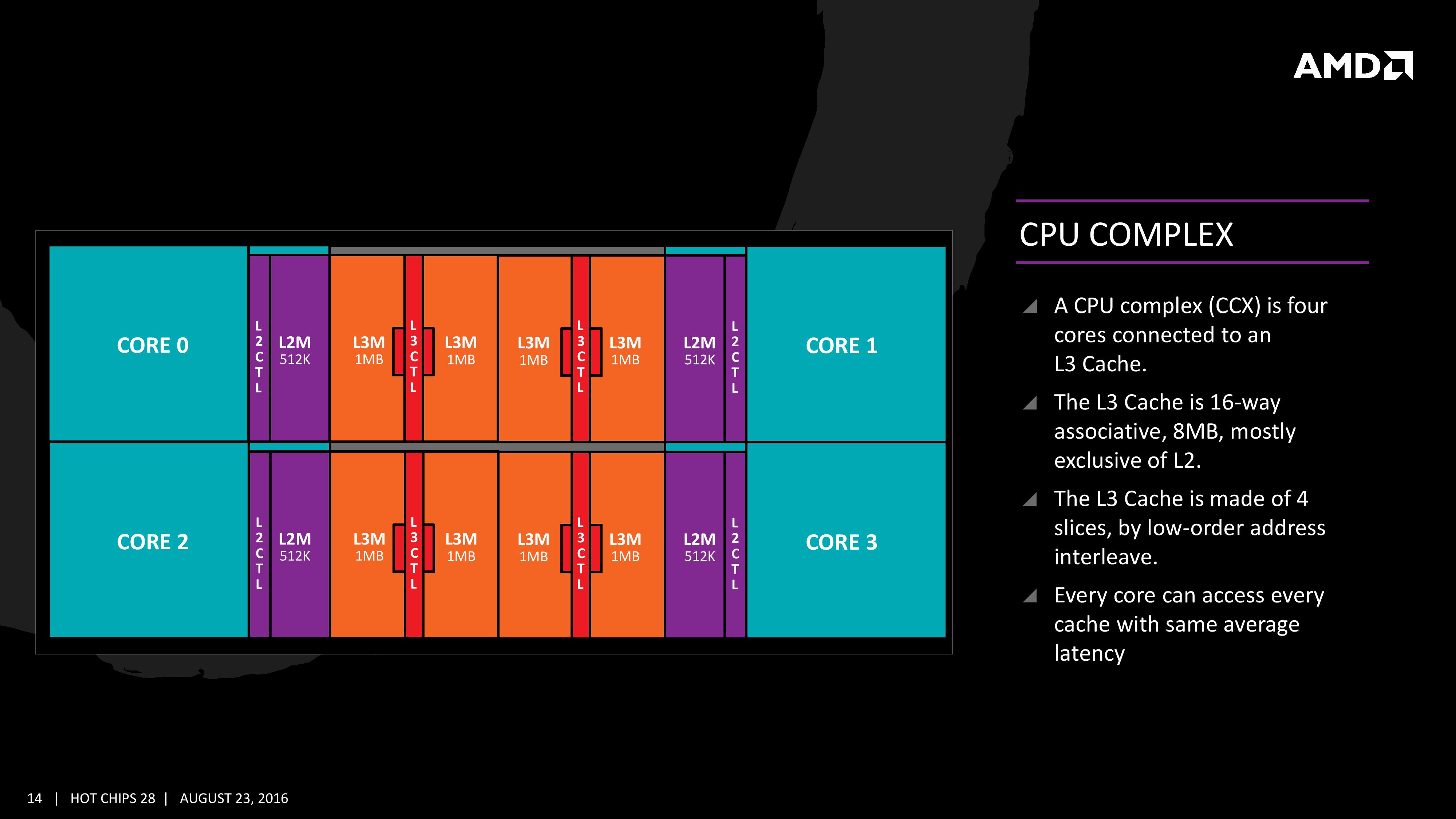AMD Zen Microarchiture Part 2: Extracting Instruction-Level Parallelism
by Ian Cutress on August 23, 2016 8:45 PM EST- Posted in
- CPUs
- AMD
- x86
- Zen
- Microarchitecture

Hot Chips is an annual conference that allows semiconductor companies to present their latest and greatest ideas or forthcoming products in an academic-style environment, and is predominantly aimed as the professional semiconductor engineer. This year has a number of talks about power management, upcoming IBM CPUs, upcoming Intel CPUs, upcoming NVIDIA SoCs and the final talk of the final day is from AMD, discussing Zen in even more depth than the previous week. While we were unable to attend the event in person, we managed to get some hands on time with information and put questions to Mike Clark, AMD Senior Fellow and design engineer.
What We Learned Last Week: L1/L2/L3 Caches and the Micro-Op Buffer
In AMD’s initial presentation for the general media, we were given a sense of the microarchitecture layout. We covered the material, but it contained a number of highlights.
AMD Zen Microarchitecture: Dual Schedulers, Micro-op Cache and Memory Hierarchy Revealed
AMD Server CPUs and Motherboard Analysis
Unpacking AMD's Zen Benchmark: Is Zen actually 2% Faster than Broadwell?
First up, and the most important, was the announcement of the inclusion of a micro-op cache. This allows for instructions that are frequently used to be closer to the micro-op queue and saves a trip through the core and caches to load the desired information. Typically micro-op caches are still relatively small, and while AMD isn’t giving any information for size and accessibility, we know that Intel’s version can support 1536 uOps with 8-way associativity; we expect AMD’s to be similar though there are many options in play.
Secondly is the cache structure. We were given details for the L1, L2 and L3 cache sizes, along with associativity, to compare it to former microarchitectures as well as Intel’s offering.
| CPU Cache Comparison | |||||
| Zen HEDT |
Bulldozer HEDT |
Excavator |
Skylake | Broadwell HEDT |
|
| L1-I | 64KB/core | 64KB/module | 96KB/module | 32KB/core | 32KB/core |
| 4-way | 2-way | 3-way | 8-way | 8-way | |
| L1-D | 32KB/core | 16KB/thread | 32KB/thread | 32KB/core | 32KB/core |
| 8-way | 4-way | 8-way | 8-way | 8-way | |
| L2 | 512KB/core | 1MB/thread | 512KB/thread | 256KB/core | 256KB/core |
| 8-way | 16-way | 16-way | 4-way | 8-way | |
| L3 | 2MB/core | 1MB/thread | - | >2MB/core | 1.5-3MB/core |
| 16-way | 64-way | - | 16-way | 16/20-way | |
| L3 Type | Victim | Victim | - | Write-back | Write-back |
In this case, AMD has given Zen a 64KB L1 Instruction cache per core with 4-way associativity, with a lop-sided 32KB L1 Data cache per core with 8-way associativity. The size and accessibility determines how frequently a cache line is missed, and it is typically a trade-off for die area and power (larger caches require more die area, more associativity usually costs power). The instruction cache, per cycle, can afford a 32byte fetch while the data cache allows for 2x 16-byte loads and one 16-byte store per cycle. AMD stated that allowing two D-cache loads per cycle is more representative of the most workloads that end up with more loads than stores.
The L2 is a large 512 KB, 8-way cache per core. This is double the size of Intel’s 256 KB 4-way cache in Skylake or 256 KB 8-way cache in Broadwell. Typically doubling the cache size affords a 1.414 (square root of 2) better chance of a cache hit, reducing the need to go further out to find data, but comes at the expense of die area. This will have a big impact on a lot of performance metrics, and AMD is promoting faster cache-to-cache transfers than previous generations. Both the L1 and L2 caches are write-back caches, improving over the L1 write-through cache in Bulldozer.
The L3 cache is an 8MB 16-way cache, although at the time last week it was not specified over how many cores this was. From the data release today, we can confirm rumors that this 8 MB cache is split over a four-core module, affording 2 MB of L3 cache per core or 16 MB of L3 cache for the whole 8-core Zen CPU. These two 8 MB caches are separate, so act as a last-level cache per 4-core module with the appropriate hooks into the other L3 to determine if data is needed. As part of the talk today we also learned that the L3 is a pure victim cache for L1/L2 victims, rather than a cache for prefetch/demand data, which tempers the expectations a little but the large L2 will make up for this. We’ll discuss it as part of today’s announcement.
The mid-week release also gave insight into the dual schedulers, one for INT and another for FP, which is different to Intel’s joint scheduler/buffer implementation. The talk at Hot Chips goes into detail about how the dispatch and schedulers operate
The New Information
As part of the Hot Chips presentation, AMD is reaffirming its commitment to at least +40% IPC improvement over Excavator. This has specifically been listed as a throughput goal at an equivalent energy per cycle, resulting in an increase in efficiency. Obviously a number of benefits come from moving the 28nm TSMC process to GloFo’s 14nm FinFET process which is used via a Samsung licence. Both the smaller node and FinFET improvements have been well documented so we won’t go over them here, but AMD is stating that Zen is much more than this as a direct improvement to immediate performance, not just efficiency. While Zen is initially a high-performance x86 core at heart, it is designed to scale all the way from notebooks to supercomputers, or from where the Cat cores (such as Jaguar and Puma) were all the way up to the old Opterons and beyond, all with at least +40% IPC.
The first immediate image out of the presentation is the CPU Complex (a CCX), which shows the Zen core design as a four-CPU cluster with caches. This shows the L2/L3 cache breakdown, and also confirms 2MB of L3 per core with 8 MB of L3 per CCX. It also states that the L3 is mostly exclusive of the L2 cache, which stems from the L3 cache as a victim cache for L2 data. AMD is stating that the protocols involved in the L3 cache design allow each core to access the L3 of each other core with an average (but a range) of latencies.
Over the next few pages, we’ll go through the slides. They detail more information about the application of Simultaneous Multithreading (SMT), New Instructions, the size of various queues and buffers, the back-end of the design, the front-end of the design, fetch, decode, execute, load/store and retire segments.














106 Comments
View All Comments
Bulat Ziganshin - Wednesday, August 24, 2016 - link
I think it's obvious from number of ALUs that 40% improvement is for scalar single-thread code that greartly bemnefits from access to all 4 integer ALUs. Of course, it will get the same benefit fro any code running up to 8 threads (for 8-core Zen). But anyway it should be slower than KabyLake since Intel spent much more time optimizng their CPUsFor m/t execution, improvements will be much smaller, 10-20%, i think. Plus, 8-core CPU will probably run at smaller frequency than 4-core Buldozers or 4-core KabyLake. AFAIK, even Intel 8c-ore CPUs run at 3.2 GHz only, and it's after many years of power optimization. We also know that *selected* Zen cpus run at 3.2 GHz in benchamrks. So, i expect either < 3 GHz frequency, or 200 Wt power budget
atomsymbol - Wednesday, August 24, 2016 - link
"For m/t execution, improvements will be much smaller, 10-20%, i think."There are bottlenecks in Bulldozer-family when a module is running two threads. An improvement of 40% for m/t Zen execution in respect to Bulldozer m/t execution is possible. It is a question of what the baseline of measurement is.
Bulat Ziganshin - Wednesday, August 24, 2016 - link
M/t execution in Bulldozer already can use all 4 INT alus, so i think that 40% IPC improvement is impossible. In other words, if s/t IPC improved by 40% by moving from 2 alu to 4 alu arrangement, m/t performance that keeps the same 4 alu arrangement, hardly can be improved by more than 20%looncraz - Wednesday, August 24, 2016 - link
IPC is NOT MT, it is ST only.IPC is per-core, per-thread, per-clock, instruction retire rate... which generally equates to performance per clock per core per thread.
Bulat Ziganshin - Thursday, August 25, 2016 - link
you can measure instruction per cycles for a thread, 3 threads, core, cpu or anything else. what's a problem??My point is that s/t speed on Zen is improved much more than m/t speed, compared to last in Bulldozer family. So, they advertized improvement in s/t speed, that is 40%. And m/t improvement is much less since it still the same 4 alus (although many other parts become wider).
atomsymbol - Thursday, August 25, 2016 - link
AMD presentation was comparing Zen to Broadwell in a m/t workload with all CPU cores utilized.From
http://www.cpu-world.com/Compare/528/AMD_A10-Serie...
you can compute that the Blender-specific speedup of Zen over a previous AMD design is about 100/38.8=2.57
Bulat Ziganshin - Thursday, August 25, 2016 - link
Can you compute IPC improvement, that we are discussing here?looncraz - Thursday, August 25, 2016 - link
Except you're absolutely wrong, the performance increases will be much higher for MT than ST.Bulldozer was hindered by the module design, so you had poor MT scaling - not an issue with Zen. On top of that, Zen has SMT, which should add another 20% or so more MT performance for the same number of cores.
A 40% ST improvement for Zen could easily mean a 100% performance improvement for MT.
Bulat Ziganshin - Saturday, August 27, 2016 - link
It's not "on top of that". Zen is pretty simple Bulldozer modification that fianlly allowed to use all 4 scalar ALUs in the module for the single thread. It's why scalar s/t perfroamnce should be 40% faster. OTOH, two threads in the module still share those 4 scalar ALUs as before, so m/t perfromance cannot improve much. On top of that, module was renamed to core. So, there are 2x more cores now and of course m/t performance of entire CPU will be 2x higherNenad - Thursday, September 8, 2016 - link
It is possible that AMD already count SMT (hyperthreading) into those 40%.Their slide which states "40% IPC Performance Uplift" also lists all things that AMD used to achieve those 40%...and first among those listed things is "Two threads per core". So if AMD already counted that into their 40% IPC uplift, then 'real' IPC improvement (for single thread) would be much lower.